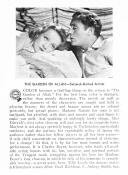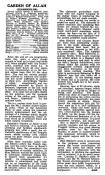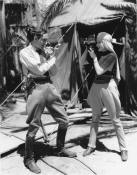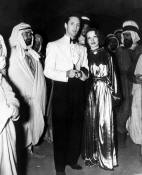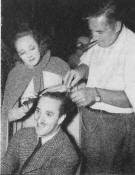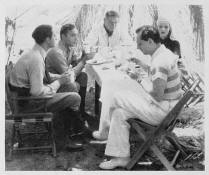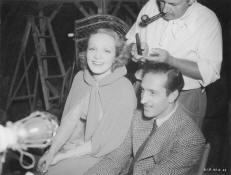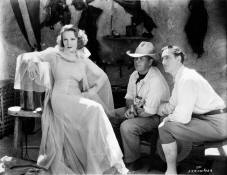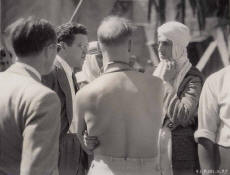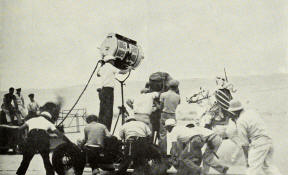The
Garden of Allah
|
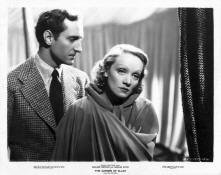 Basil Rathbone and Marlene Dietrich |
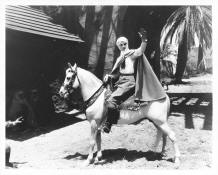 Big white Arabian stallion is named Jadaan. 17 years earlier, Rudolph Valentino rode Jadaan in The Four Horsemen of the Apocalypse. |
"Basil Rathbone and C. Aubrey Smith are excellent in fleeting supporting roles." —J. T. M., The New York Times, November 20, 1936
"Rathbone's role as the loyal friend to Domini was rather colorless, but the performer did what he could with it. He had one good scene toward the end, however, when he forces Boris to face up to his past deeds." —Michael B. Druxman, Basil Rathbone: His Life and His Films
|
Color becomes a thrilling thing on the screen in "The Garden of Allah." For the first time, color is dramatic, rather than merely decorative. The moods as well as the manners of the characters are caught and held in glowing beauty; the desert and bazaar scenes are no colored postcards, but actual places; Madame Nature for once is not maligned, but glorified, with skies and sunsets and sand dunes to make you melt. And speaking of meltingly lovely things, Miss Dietrich's first color close-up will awe you for its exquisite tones. Marlene is not always perfectly happy in Technicolor, particularly outdoors; and she pursues her regrettable policy of facing the audience rather than her fellow players in all her best scenes—if only she'd concentrate on characterization instead of close-ups, for a change! At that, it is by far her most human and warm performance. It is Charles Boyer, however, who steals all available acting honors with his fine, sensitive, and spiritual portrait of the Trappist monk struggling against his love for Marlene. Boyer's long close-up in which he tells of his torments is remarkably moving—a great actor, here. Tilly Losch, the dancer, makes a triumphant screen debut. Basil Rathbone, C. Aubrey Smith, fine. —Delight Evans, Screenland, January 1937 |
"Artistically this is an outstanding picture; the production and acting are superb, and the color and musical score add to the atmospheric setting." —Harrison's Reports, November 28, 1936
"The tale itself remains one in which romantic and religious fervor are substitutes for dramatic urgency, but it is acted sensitively and at times brilliantly by Marlene Dietrich, Charles Boyer, and an able supporting company." —Herald Tribune
"The cinema's most astute and tasteful use of natural color photography to date." —Literary Digest
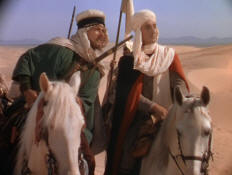 Count Anteoni has located the encampment where Boris and Domini are staying. |
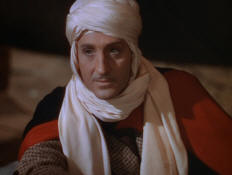 Anteoni greets Domini. |
"A true symphony in color ... Selznick International gains the record for the furthest advance in application of the varied hues ... splendidly chosen for her beauty in the medium is Marlene Dietrich, who becomes a pace maker for sheer radiance of presence, and who has never appeared to such advantage in any picture. An acting triumph is won by Charles Boyer. A great accomplishment for Richard Boleslawski, a director." —Los Angeles Times
"The finest drama of the year and one of producer David O. Selznick's greatest. The most beautiful picture ever made, with the finest performances in the careers of Marlene Dietrich and Charles Boyer. La Dietrich takes her place among the greatest beauties of history." —E. J. Smithson, Movie Classic
"'The Garden of Allah' shows how close we are to the time when all pictures will be made in color. I enjoyed 'The Garden of Allah' tremendously. Marlene Dietrich is radiantly beautiful." —Paul Harrison, N. E. A.
|
The Technicolor version of the Robert Hichens novel, a best seller of several generations ago, is by far the most beautiful of the color pictures. Never on stage or screen have you seen anything so breathtakingly lovely as the silhouettes of desert caravans against the rising and the setting sun. Marlene Dietrich is certainly one of the Glamour Girls who takes to color like a duck to water. The glamorous Marlene is simply ravishing in her close-ups, and her reddish gold hair, clear blue eyes, and perfect profile make her the most beautiful of the stars yet to be seen in technicolor. Co-starring with Marlene is Charles Boyer, the handsome French actor who has a devastating appeal to women. The story, alas, is not nearly so exciting as the color and the stars. As you probably remember, it's about a Trappist monk who breaks his solemn vows to the Church and runs away from his monastery in Northern Africa to see the world. In a nearby desert town he meets and marries a young woman who has also just escaped from a life of repression. The monk is continually haunted by his broken vows, and this secret gradually becomes a definite barrier between them. Finally he confesses to her what he has done, renounces his love and worldly delights, and returns to his monastery to seek again a peace of soul. No matter how beautiful the color and Marlene, it is still the story of the renegade monk. A pictorial highlight of the picture is the dance sequence of Tilly Losch. Also in the cast, and excellent, are Joseph Schildkraut as a poetic desert courier, Basil Rathbone as Count Anteoni, and Lucile Watson as a mother superior. —Silver Screen, January 1937 |
"Aided by beautiful Technicolor, a musical score that must be ranked with the season's best, backed by two strong names, good feature players, 'The Garden of Allah' should please best in class houses." —The Philadelphia Exhibitor, November 15, 1936
"Although acting honors go to Charles Boyer, Marlene Dietrich acquits herself surprisingly well in a role eminently suited to her special talents. ... There are also capable performances by Joseph Schildraut, John Carradine, Basil Rathbone and C. Aubrey Smith." —Modern Screen, January 1937
"Beyond argument this screen version of Robert Hitchers' desert romance is one of the most beautiful color pictures ever made." —Movie Classic, February 1937
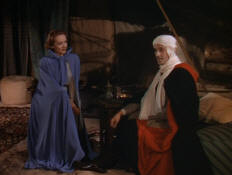 Domini invites Count Anteoni to stay for dinner. |
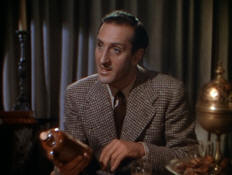 Anteoni tells the story of the monk who broke his vows, and says, "There must be anguish and despair. He has no right to the delights of the world." |
"Superb in its production qualities and emotionally arresting, with the drama enhanced by the most discriminating use of Technicolor thus far, 'The Garden of Allah' comes to the screen as entertainment of highest appeal and sturdy box-office caliber ... Boyer and Dietrich are seen at their best. Dietrich gives the most persuasively human performance of her career." —Daily Variety
"The Garden of Allah is the greatest Technicolor picture ever made. This beautiful production will prove to be a sure fire box-office sensation. Marlene Dietrich and Charles Boyer give the greatest performances of their entire career. David O. Selznick has produced another mighty hit." —Lloyd Pantages
|
Since life and art are progressive, some day, soon, a story sturdy enough to hold up in black and white will, when coupled with the Technicolor, combine into socko b.o. It resolves itself down all over again, in color cinematurgy or in the normal screen hues, that it's the story first. The rest are merely production niceties to enhance and embellish but never sufficient to sustain on their own. Accordingly 'Garden of Allah,' sumptuously and impressively mounted by David O. Selznick, impresses as the last word in color production, but a pretty dull affair. It'll come out all right chiefly on the ballyhoo and the marquee values of the stellar pair, Dietrich and Boyer. Especially for the matinee trade. The b.o. answer finds itself in perhaps the No. 1 feature money-maker in color, 'Trail of the Lonesome Pine,' to date, where the prismatic camera enhancement had the advantage of a romance which, despite its backwoods familiarity, could almost stand up in ordinary black and white camera treatment. Selznick's 'Garden of Allah' is the last word in coloring. It is optically arresting and betimes emotionally gripping but, after a spell, the ecclesiastic significance of the Trappist monk whose earthly love cannot usurp his prior secular vows peters out completely. After their romantic safari into the Sahara—when the French captain and the count learn of Boyer's desertion from the monastery—the renunciation of earthly emotions, as Miss Dietrich escorts the monk back to sanctuary, somehow misses fire. It doesn't click emotionally; it's vapid, its romanticism, once the premise is established; and irises-out on an impression of the sands of the desert which have grown cold 20 minutes before the final camera portrait shot. The cinematic portraiture combines with the expert trouping of the stellar twain in bolstering the proceedings, but not quite enough. As a motion picture, the screen is asked too much of. The demands to reflect emotions into satisfying film drama are almost beyond the medium. In literature, Hichens' novel could word-paint something which neither the lens—on the face of it a more advantageous medium—nor the screen artificers could achieve. Miss Dietrich and Charles Boyer are more than adequately competent in the leads although sometimes slurring their lines. But in the main they impress in the difficult roles. The support is likewise ultra. Basil Rathbone, C. Aubrey Smith, Tilly Losch (making her screen debut in a Bagdad cafe dancing sequence, and okay in what she does), Joseph Schildkraut (who almost steals the picture with his exaggerated oriental ingratiations) and John Carradine as the sandseer leave nothing wanting. The color is particularly flattering to Miss Dietrich who has also taken off a little weight. In the flowing capes to which she is so partial, the color camera has caught her at her photographic best. Running time of 80 minutes, while not abnormal, appears longer, which is invariably a tip-off on calibre of script and direction. Yet Boleslawski has done an expert technical job in motivating the action and the Lipscomb-Riggs continuity has been wisely sparing of dialog. Which leaves the impression that the 'action,' such as it is, isn't sufficiently actionful. Shots and more shots of the desert, silhouettes against sunsets, caravanseries into the Garden of Allah (as the Arabs call the Sahara), bivouacked Bedouins, et al. do not make for cinematurgy. It's good incidental by-play, but that's all. Nor is Boyer's struggle between worldly pursuits and his return to Trappist celibacy any great stirring premise, save for the femmes. 'Garden of Allah' as matinee fodder thus impresses favorably, which in one aspect augurs well for its box-office. Max Steiner's score is second only to the gorgeous color cameraing, among the major contributory aspects. His music has really been called upon to collaborate with the histrrionism in pitching the emotions, and he achieves it in no small measure. Lansing C. Holden's color direction and the W. Howard Green-Hal Rossen cinematographic collaboration more than fulfill requirements from the lens adjunct which, in a production of this nature, is no small component. Abel. —Variety, November 25, 1936 |
"Selznick's 'Allah' production of beauty, artistry, charm. Artistically the most beautiful and atmospherically compelling picture ever made. Its use of color to enhance mood and incident goes considerably beyond anything hitherto attempted ... will win wide and heart praise. Strong portrayals from Marlene Dietrich and Charles Boyer. It is, at last, a part worthy of her. Richard Boleslawski's direction is masterful." —Hollywood Reporter
"By far the best color picture to date, 'The Garden of Allah' for sheer beauty is unsurpassed, and the greatest beauty of these is Dietrich." —Virginia Wood, Screenland
"It is the most superbly, subtly artistic production I have ever seen, with an added importance because it sets a new standard for color on the screen." —Reha, Screen Play
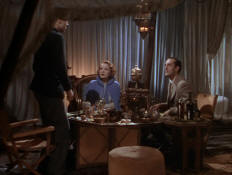 Domini realizes that the monk who fled is Boris. |
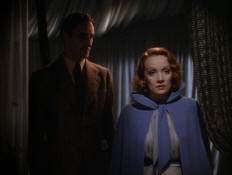 I knew you would prefer the truth. |
"'The Garden of Allah' is brilliantly done, the best Technicolor picture so far. It is an exceptionally outstanding drama that will appeal to everybody." —Leo Townsend, Modern Screen
"Dietrich and Boyer achieve the finest performances of their careers. ... Color is written into the picture with the same care as the dialogue." —Newsweek
"Flagrantly silly romance set in the Algerian desert; full of ripe dialogue, troubled glances, beauty shots of Marlene in a variety of gorgeous sheaths and flowing gowns, and some wonderful Technicolor scenery (which helped win its cameramen, W. Howard Greene and Harold Rosson, a special Oscar). It just isn't very good." —Leonard Maltin, Leonard Maltin's Classic Movie Guide, 2015
Candid Photos
See Page Three for pictures of posters, lobby cards and promo photos.







